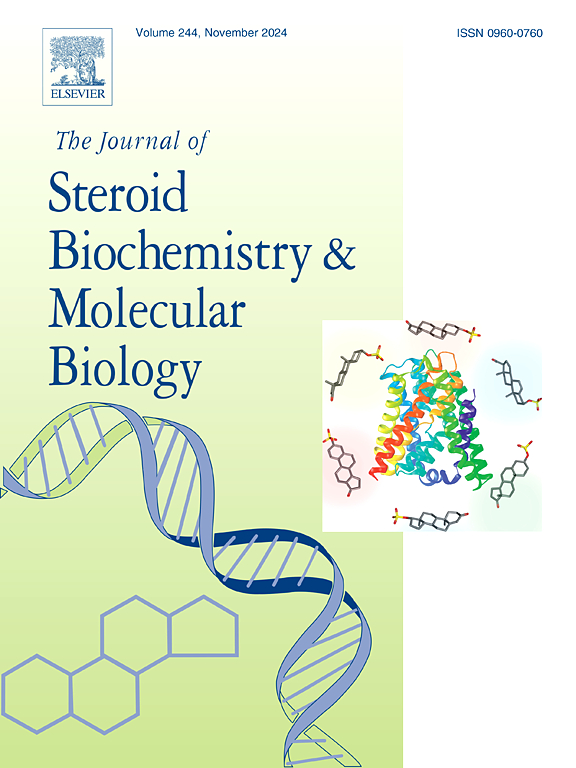17β-雌二醇(E2)通过膜雌激素受体β增加纤毛搏动频率。
IF 2.5
2区 生物学
Q3 BIOCHEMISTRY & MOLECULAR BIOLOGY
Journal of Steroid Biochemistry and Molecular Biology
Pub Date : 2025-09-29
DOI:10.1016/j.jsbmb.2025.106871
引用次数: 0
摘要
雌激素受体(ER)在各种组织中表达,包括肺和其他呼吸组织,与性别无关。然而,雌激素在呼吸道中的作用尚不完全清楚。气道纤毛细胞在粘膜纤毛清除(mucociliary clearance, MCC)中起着重要的作用,而纤毛搏动频率(ciliary beat frequency, CBF)是MCC效率的重要指标。虽然雌激素在气道平滑肌细胞和杯状细胞中的作用已被研究,但其对气道纤毛细胞的影响尚不清楚。在这里,我们研究了17β-雌二醇(E2)对CBF的影响。E2增加小鼠气道纤毛细胞的CBF和细胞内cAMP浓度([cAMP]i),而对细胞内Ca2+浓度和细胞内ph没有影响。选择性ERβ抑制剂PHTPP抑制E2诱导的CBF和[cAMP]i的增加。β-雌二醇6-(o -羧甲基)肟:牛血清白蛋白偶联物,激活膜内质网,也增加小鼠气道纤毛细胞的CBF和[cAMP]i,而PHTPP抑制了这些作用。本研究结果表明,E2通过小鼠气道纤毛细胞膜ERβ增加[cAMP]i,从而增加CBF。这些结果为雌激素在气道纤毛细胞中的作用提供了新的认识。本文章由计算机程序翻译,如有差异,请以英文原文为准。
17β-estradiol (E2) increases ciliary beat frequency via membrane estrogen receptor β
Estrogen receptors (ER) are expressed in various tissues, including the lungs and other respiratory tissues, independent of sex. However, the role of estrogen in the respiratory tract is not fully understood. Airway ciliated cells are important for mucociliary clearance (MCC), which protects the human airways from foreign substances, and ciliary beat frequency (CBF) is an important indicator of MCC efficiency. Although the function of estrogen in airway smooth muscle cells and goblet cells has been studied, its effects on airway ciliated cells remain unclear. Here, we investigated the effect of 17β-estradiol (E2) on CBF. E2 increased CBF and intracellular cAMP concentration ([cAMP]i) in murine airway ciliated cells, whereas it had no effect on intracellular Ca2 + concentration and intracellular pH. The selective ERβ inhibitor PHTPP suppressed the E2-induced increase in CBF and [cAMP]i. β-Estradiol 6-(O-carboxymethyl)oxime: bovine serum albumin conjugate, which activates membrane ER, also increased CBF and [cAMP]i in murine airway ciliated cells, and PHTPP suppressed these effects. The results of this study indicate that E2 increases CBF by increasing [cAMP]i via membrane ERβ in murine airway ciliated cells. These results provide new insight into the function of estrogen in airway ciliated cells.
求助全文
通过发布文献求助,成功后即可免费获取论文全文。
去求助
来源期刊
CiteScore
8.60
自引率
2.40%
发文量
113
审稿时长
46 days
期刊介绍:
The Journal of Steroid Biochemistry and Molecular Biology is devoted to new experimental and theoretical developments in areas related to steroids including vitamin D, lipids and their metabolomics. The Journal publishes a variety of contributions, including original articles, general and focused reviews, and rapid communications (brief articles of particular interest and clear novelty). Selected cutting-edge topics will be addressed in Special Issues managed by Guest Editors. Special Issues will contain both commissioned reviews and original research papers to provide comprehensive coverage of specific topics, and all submissions will undergo rigorous peer-review prior to publication.

 求助内容:
求助内容: 应助结果提醒方式:
应助结果提醒方式:


